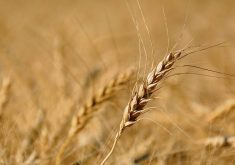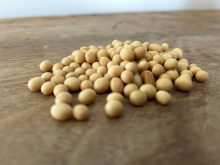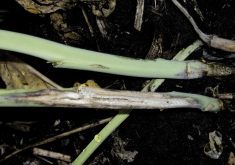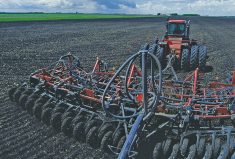The oil content of this year’s canola crop is not great.
When the Canadian Grain Commission took stock of the mean oil content from its submitted samples for 2024, values came back at 42.6 per cent. This year’s average is not as bad as 2021, when severe drought withered oil yield to 41.3 per cent, but reports are coming in well below the 10-year average.
The reason for lower oil content is pretty simple, said Veronique Barthet, program manager for oilseeds monitoring with the grain commission. Hot and dry weather in July and August, especially warm nights, prevented canola plants from producing oil inside the seed.
Read Also

Scouting for disease in canola crops
Inspecting your canola fields for early signs of disease can save you plenty of headaches in the long run.
“During the cool nights, the crop has time to recover. This was not the case this year,” said Barthet, who spoke Dec. 3 at Canola Week, a Canola Council of Canada event in Saskatoon. “So, there is lower oil content …. The good news? It’s not as low as 2021.”
This year is just the latest to post below-average oil. The three years from 2021-24 showed lower oil content than the decade before. From 2010-20, oil content was consistently around 44 per cent or higher.
Supply impacts
Canola with less oil in the seed means less oil production at crushing plants across the Prairies.
“The recent drop in average oil content has been unfortunate. We chalk it up to the hot and dry weather experienced in recent crop years,” said Chris Vervaet, Canadian Oilseed Processors Association executive director.
“We will be keeping a close eye on this going forward to determine if other factors might be at play.”
Other quality
Barthet shared other data on the quality of the 2024 crop, noting 90 per cent of samples sent to the grain commission graded No. 1. The grade was particularly high in Saskatchewan, but less so in Manitoba. About 70 per cent of samples were rated No.1 in eastern Manitoba and parts of the Parkland.
Protein content was also much higher than average, which is good news for canola meal users. Protein content in Western Canada was 23 per cent, while the 10 year average is 21 per cent.
As for chlorophyll, there were few green seeds in this year’s samples.
“(That’s) not genetics,” Barthet said. “As long as we have no frost in September, no frost in October, we will have low chlorophyll, which is pretty good for the crusher.”
Variety breakdown
Crop insurance data from Manitoba, Saskatchewan and Alberta shows that two canola varieties gained market share this year. L340PC and L356PC, which are InVigor hybrids, went from 26 per cent of insured acres in 2023 to 35 per cent in 2024.
Those varieties and other new hybrids made a difference for glucosinolate levels in canola seed. Normally, dry growing conditions cause glucosinolate levels to increase, but that didn’t happen in 2024. Amounts were close to the five-year average.
“The reason why is because those varieties that are high in glucosinolates are no longer in the system,” Barthet said.
As well, alpha linoleic acid content in canola oil was higher than expected in the grain commission samples. With drought, that level should drop.
“This year, there was a shift in the varieties,” Barthet said. “There is about 10 per cent more varieties … that has high alpha linoleic acid compared to last year…. It’s really a genetic effect this year.”
Submission delays
The Canada Post strike has been a challenge for the commission’s operations. Labour action among postal workers has disrupted shipment of grain samples to the CGC. The commission is asking farmers to keep their samples until the strike is over. Another option is to drop the samples at one of the CGC service centres.
















